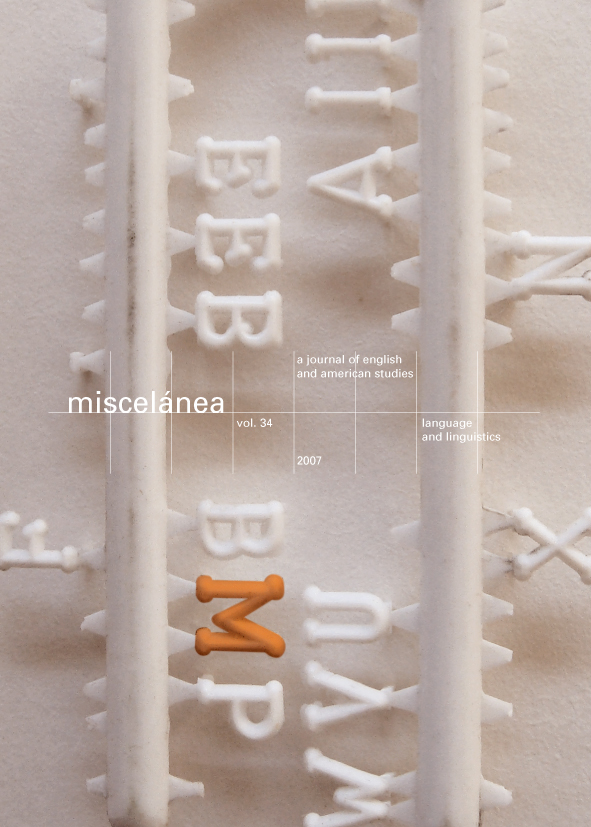Gendered Spaces and Female Resistance: Virginia Woolf’s ‘The Mark on the Wall’
DOI:
https://doi.org/10.26754/ojs_misc/mj.200610112Keywords:
Virginia Woolf, Short story, The Mark on the Wall, Gender, Space, AnamorphosisAbstract
Virginia Woolf’s conviction that space is never a neutral emptiness, but a web of cultural, social and ideological relations is the issue at stake in the present paper. Gender and space are constructed as mutually dependant categories, and, as far as Woolf was concerned, both appear in need of revision and rethinking. Woolf’s short story “The Mark on the Wall”, published as early as 1917, dramatises such a need, while advancing certain ideological assumptions embodied in a particular imagery which will reappear in some of her later work. The mark on the wall, both the title and the key image which structures the narrative, emerges as a disturbing block that threatens to diminish order and coherence within the confines of the space which the traditional living-room entails, by focusing on the narrator’s subversive and tantalising reflections.
Display downloads
References
BACHELARD, Gaston. 1958. The Poetics of Space. Trans. Maria Jolas. Boston: Beacon Press.
BOUMELHA, Penny. 1982. Thomas Hardy and Women: Sexual Ideology and Narrative Form. Madison: The University of Wisconsin Press.
BOWLBY, Rachel. 1997. “‘We’re Getting There’: Woolf, Trains, and the Destination of Feminist Criticism”. In Rachel Bowlby. (ed.). Feminist Destinations and Further Essays on Virginia Woolf. Edinburgh: Edinburgh U.P: 3-15.
CYR, Marc. D. 1996. “A Conflict of Closure in Virginia Woolf’s ‘The Mark on the Wall’”. Studies in Short Fiction 33 (2): 197-205.
DENISOFF, Dennis. 1999. “‘The Forest Beyond the Frame’: Picturing Women’s Desire in Vernon Lee and Virginia Woolf”. In Talia Schaffer and Kathy Alexis Psomiades. (eds.). Women and British Aestheticism. Charlottesville and London: University of Virginia Press: 251-269.
ELLMANN, Maud. 1988. The Poetics of Impersonality: T.S. Eliot and Ezra Pound. Cambridge, Massachusetts: Harvard U.P.
FREUD, Sigmund. 1957. “Beyond the Pleasure Pinciple”. A General Selection from The Works of Sigmund Freud. Ed. John Rickman. New York: Doubleday: 141-168.
FOUCAULT, Michel. 1972-1977. “The Eye of Power”. Power/Knowledge: Selected Interviews and Other Writings 1972-1977. Ed. Colin Gordon. New York: Pantheon Books: 146-165.
—. 1984. “Space, Knowledge, Power”. The Foucault Reader. Ed. Paul Rabinow. New York: Pantheon Books: 239-257.
GILLESPIE, Diane. 1988. The Sisters’ Arts: The Writing and Painting of Virginia Woolf and Vanessa Bell. Syracuse, N.Y.: Syracuse U.P.
HAWKES, Ellen. 1981. “Woolf’s Magical Garden of Women”. In Jane Marcus (ed.). New Feminist Essays on Virginia Woolf. Nebraska: University of Nebraska Press: 31-60.
JAMESON, Fredric. 1988. “Architecture and the Critique of Ideology”. The Ideologies of Theory: Essays 1971-1986. Volume 2: The Syntax of History. London: Routledge. 35-60.
KRISTEVA, Julia. 1986. “Women’s Time”. The Kristeva Reader. Ed. Toril Moi. Oxford: Blackwell: 187-213.
LACAN, Jacques. 1978. The Seminar of Jacques Lacan. Book XI: The Four Fundamental Concepts of Psychoanalysis. New York: Norton.
LEFEBVRE, Henri. 1991. The Production of Space. Trans. Donald Nicholson-Smith. Oxford: Blackwell.
PATER, Walter. 1986. The Renaissance: Studies in Art and Poetry. Oxford: World’s Classics.
RENDELL, Jane, Barbara PENNER and Iain BOORDEN. (eds.). 2003. Gender Space Architecture: An Interdisciplinary Introduction. London: Routledge.
SEELEY, Tracy. 1996. “Virginia Woolf’s Poetics of Space: ‘The Lady in the Looking-Glass: A Reflection’”. Woolf Studies Annual 2: 89-116.
VLASOPOLOS, Anca. 1994. “Staking Claims for No Territory: The Sea as Women’s Place”. In Margaret Higonnet and Joan Templeton. (eds.). Reconfigured Spheres: Feminist Explorations of Literary Space. Amherst: University of Massachusetts Press: 72-88.
VILLEGAS LÓPEZ, Sonia and Beatriz DOMÍNGUEZ GARCÍA. (eds.). 2004. Literature, Gender, Space. Huelva: Servicio de Publicaciones de la Universidad.
WOOLF, Virginia. 1966. The Collected Essays of Virginia Woolf II. Ed. Leonard Woolf London: The Hogarth Press.
—. 1976. Moments of Being: The Unpublished Autobiographical Writings of Virginia Woolf. Ed. Jeanne Schulkind. Brighton: Harvester Wheatsheaf.
—. 1978. The Diary of Virginia Woolf II. Ed. Anne Oliver Bell. Harmondsworth: Penguin.
—. 1985. The Complete Shorter Fiction of Virginia Woolf. Ed. Susan Dick. London: The Hogarth Press.
—. 1992a. A Room of One’s Own/Three Guineas. Ed. Morag Shiach. Oxford: World’s Classics.
—. 1992b. A Woman’s Essays: The Selected Essays of Virginia Woolf I. Ed. Rachel Bowlby. Harmondsworth: Penguin.
—. 1993. The Crowded Dance of Modern Life: The Selected Essays of Virginia Woolf II. Ed. Rachel Bowlby. Harmondsworth: Penguin.
—. 1994. The Essays of Virginia Woolf IV. Ed. Andrew McNeillie. London: The Hogarth Press.
ZIZEK, Slavoj. 1989. The Sublime Object of Ideology. London: Verso.
—. 1991. Looking Awry: An Introduction to Lacan through Popular Culture. Cambridge, Massachusetts: The MIT Press.
—. 1999. “Courtly Love, or Woman as Thing”. The Zizek Reader. Eds. Elizabeth Wright and Edmond Wright. London: Blackwell: 150-73.
Downloads
Published
Issue
Section
License

This work is licensed under a Creative Commons Attribution-NonCommercial 4.0 International License.


